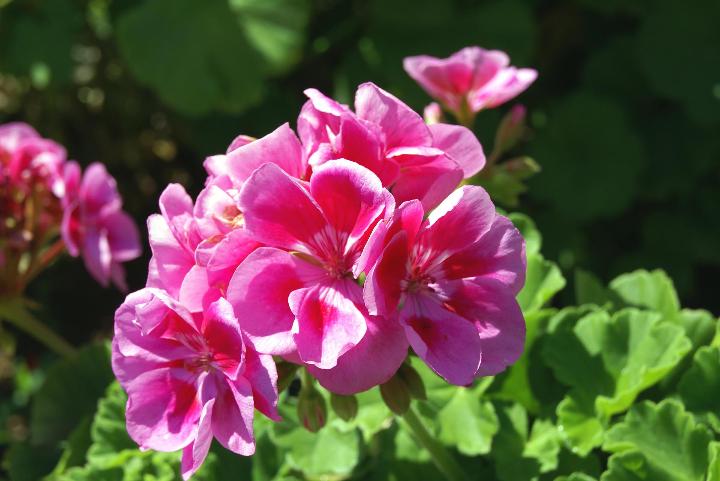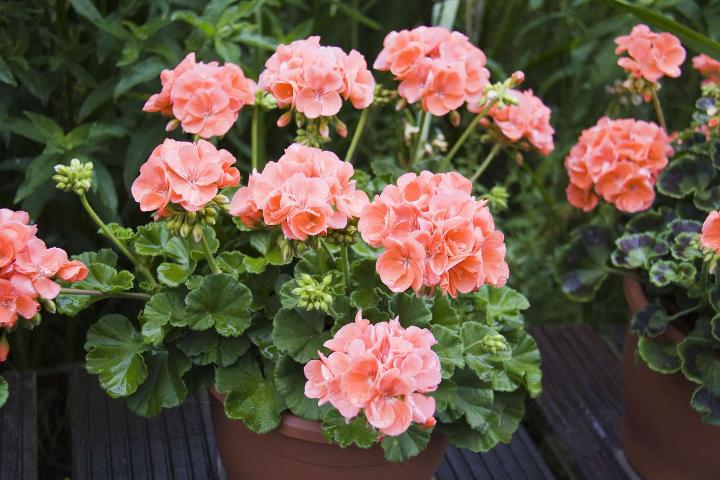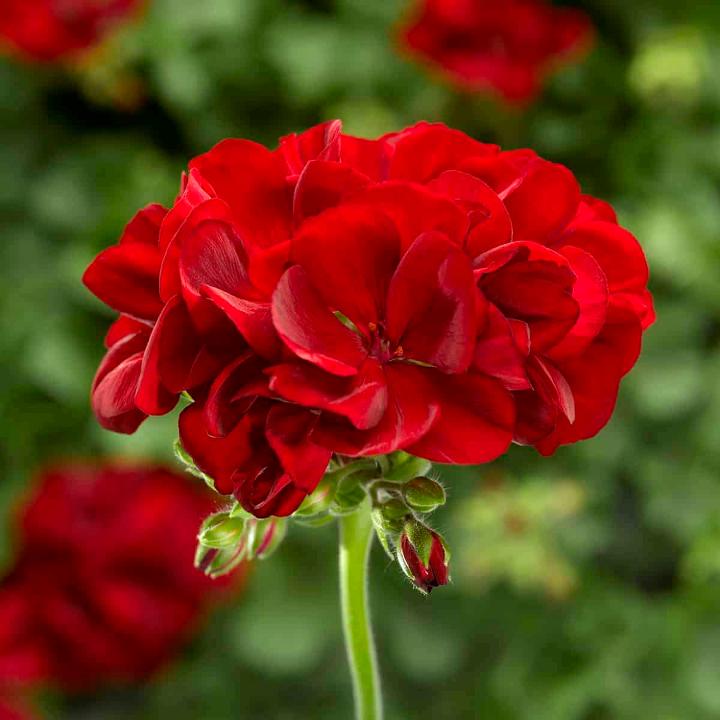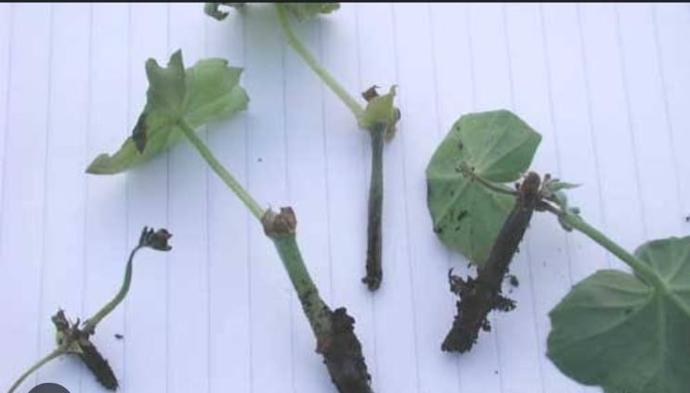Ordinary geranium Plant
Ordinary Geranium, also known as Pelargonium, is an outdoor flowering plant. Plant in well-draining soil with full sun to partial shade. Water consistently and deadhead spent flowers for continuous blooming. Pruning helps maintain a compact and bushy appearance. 
Habit
Perennial
Height
0.3-1 m
Growth
Fast
Soil
Well Drained, loamy
Shade
Full Sun
Moisture
Moist
Edible
No
Medicinal
No
Origin
Southern Africa
Climatic Condition
Temperate, Subtropical
Temperature (°)
15-25°C
Humidity (%)
50-60
Potting media
Loamy, peat
Fertilizers
Balanced NPK (10-20-10)
Watering
Regular, moderate
Plant Weight
100-150 g
Flowering Time
Spring, Summer
Soil Ph level
6.0 - 7.0
Water Ph level
6.0 - 7.5
Soil EC
1-2 dS/m
Yield Per Plant
Ornamental flowers
NPK ratio
10:20:10
life Span
Annual
Health Benefits
Used for decorative purposes, mood booster
Suggested Grow Media or Potting Mix ?
40% compost, 30% peat moss, 30% perlite
Suggested Fertigation/Fertilizers
Fertilize every 2 weeks with a balanced, water-soluble fertilizer.
Common Diseases and Remedies
Damping off , black leg .
black lesions , webby growth , coal black spots on leaves .
avoid fungicides , rogue out plants , good sanitation .
HEALTH BENEFITS
- Used in herbal medicine for skin conditions and wound healing.
- Contains antibacterial and anti-inflammatory properties.
- Some varieties have mild sedative effects, helping with relaxation.
What Is An Common Geranium?
Common Geranium, also known as Pelargonium hortorum, is a popular flowering plant grown for its bright flowers and decorative foliage. It is commonly grown in gardens, containers, and hanging baskets. Geraniums come in a variety of colors, including red, pink, white, and purple, and grow best in well-drained soil and plenty of sunlight. They are relatively easy to care for and are known for their ability to attract pollinators such as bees and butterflies. Common geranium usually refers to a species of flowering plant of the genus Pelargonium, often grown in gardens or in pots for its bright flowers and foliage. It often features clusters of round flowers in a variety of colors, including red, pink, white, and purple, and grows in well-drained soil and sunny locations. Geraniums are popular for their easy care and ability to add color to outdoor and indoor spaces.

What Are The Different Types Of Common Geranium?
1. Zoned Geraniums (Pelargonium x Hortorum)
These are the most common geraniums found in gardens and landscapes. The leaves are round, often slightly lobed, and have distinct bands or "zones" of color. It produces many flowers of various colors such as red, pink, white, and purple.
2. Ivy Leaf Geranium (Pelargonium peltatum)
Ivy Leaf Geraniums are known for their pendulous growth. It has glossy, ivy-shaped leaves and produces drooping flower stalks. It is popular for hanging baskets and containers, and its flowers come in a wide variety of colors.
3. Fragrant Geraniums (Pelargonium spp)
These geraniums are prized for their fragrant leaves that smell of rose, lemon, mint, and a variety of other scents. Although it produces flowers, it is also often cultivated for its fragrant leaves, which can be used in cooking, potpourri, and essential oils.
4. Royal geranium (Pelargonium domesticum)
Royal geranium, also known as Martha Washington geranium, produces large, showy flowers with wavy petals. They come in many bright colors and are often grown as houseplants or in sheltered areas outdoors.
5. Star Geranium (Pelargonium x domesticum)
A hybrid of zoned geranium and royal geranium, combining the characteristics of both species. It produces large flowers similar to royal geraniums, but also has band-shaped leaves.
6. Angel Geranium (Pelargonium crispum)
With its finely cut, fern-like leaves, the angel geranium looks delicate. It blooms in clusters of small single flowers and is often grown for its attractive foliage.

How To Care For Common Geranium?
1. Location
Common geraniums, also known as pelargoniums, grow in full sunlight. It prefers well-drained soil and tolerates a variety of soil types, but does not like to sit in wet soil. In addition, it is sensitive to frost. Therefore, in cold regions, try to plant it in a place that is protected from frost. In warmer regions it can be planted outdoors year-round, but in colder climates it is often grown as an annual or brought indoors during the winter.
2. Sunshine
Pelargoniums, also known as geraniums, love the sun and need 5 hours of sunlight per day. It does not require as much water as many annuals, but prefers moist, well-drained soil. It is often grown as a potted or container plant and can be kept outdoors in a semi-sunny to sunny location until frost in the fall.
3. Soil
Common geraniums, also called pelargoniums, prefer well-drained soil. A good idea is to mix equal parts potting soil, perlite, and coarse sand. This combination ensures proper root drainage and aeration, which is essential for plant health. Additionally, adding organic materials such as compost enriches the soil and provides nutrients for healthy growth. Geraniums thrive in this range, so make sure your soil is slightly acidic to neutral, with a pH between 6.0 and 7.0.
4. Hydration
Proper hydration of common geraniums is essential to the health and growth of geraniums. Water generously when the soil surface becomes dry. Provide good drainage to prevent water blockages that can cause root rot. Water more frequently in hot weather, but be careful not to overwater. Also, avoid getting the leaves wet to prevent disease.

5. Nourishment
Feed common geraniums with a balanced fertilizer containing equal amounts of nitrogen, phosphorus, and potassium (N-P-K). A general purpose fertilizer with a 10-10-10 or 20-20-20 ratio is suitable. Fertilize according to package directions, usually every 4 to 6 weeks during the growing season. Also, make sure your geraniums receive plenty of sunlight, water, and well-drained soil for optimal growth.
6. Issues
Stem When a systemic infection occurs, typical wilt symptoms appear throughout the plant, often appearing first on the lower leaves. Leaves droop and branches wither. The stems may turn black, shrivel, and dry rot. Infected cuttings will not form roots and will slowly rot from the base. The stems become dull and black.
What Are The Benefits Of Common Geranium
Aesthetic Appeal Geraniums are prized for their vibrant flowers and lush foliage, adding beauty to gardens, balconies, and indoor spaces. Low Maintenance They are relatively easy to grow, requiring minimal care once established, making them suitable for beginner gardeners. Long Blooming Season: Geraniums produce blooms continuously throughout the growing season, providing color and interest for several months. Versatility They thrive in various conditions, including full sun to partial shade, and can be grown in containers, hanging baskets, or garden beds. Attract Pollinators The flowers attract pollinators such as bees and butterflies, promoting biodiversity in the garden. Aromatic Foliage Some varieties have fragrant leaves, adding a pleasant scent to the garden when brushed against or crushed. Repel Insects The strong aroma of geranium leaves can act as a natural insect repellent, helping to deter pests like mosquitoes and flies. Medicinal Uses In traditional medicine, geraniums have been used for various purposes, including treating minor wounds, skin irritations, and respiratory issues.

FAQs About Growing Common Geranium
1. How to maintain ordinary geranium?
Watering Geraniums prefer slightly dry conditions, so water them when the top inch of soil feels dry. Overwatering can lead to root rot, while underwatering can cause wilting. Sunlight Place geraniums in an area with full sun for at least 6-8 hours a day. They thrive in bright, indirect light. Fertilizing Use a balanced fertilizer every 4-6 weeks during the growing season (spring to fall). Avoid fertilizing during winter when growth slows down. Pruning Regularly pinch back leggy stems to encourage bushiness and more flower production. Remove spent blooms to promote continuous flowering. Repotting Repot geraniums every 1-2 years to refresh the soil and provide more space for root growth. Choose a well-draining potting mix. Pest and Disease Control Keep an eye out for common pests like aphids, whiteflies, and spider mites. Treat infestations promptly with insecticidal soap or neem oil. Prevent fungal diseases by avoiding overhead watering and providing good air circulation around plants. Winter Care In colder climates, bring geraniums indoors before the first frost. Place them in a sunny window and reduce watering frequency. You can also cut them back by one-third to prevent legginess.
2. What are the uses of ordinary geranium?
Ornamental Purposes They are commonly grown for their attractive flowers and foliage, used in gardens, borders, hanging baskets, and containers to add color and beauty to outdoor spaces. Indoor Decoration Geraniums can be grown indoors as houseplants, adding color and vibrancy to indoor environments. Aromatherapy Some varieties of geraniums are valued for their pleasant fragrance, which can be used in aromatherapy for relaxation and stress relief. Medicinal Uses In traditional medicine, geraniums have been used for their supposed medicinal properties, including as a remedy for various ailments such as inflammation, wounds, and skin conditions. However, scientific evidence supporting these claims is limited. Insect Repellent The scent of geraniums is believed to repel certain insects like mosquitoes and flies, making them useful as natural insect repellents in gardens and outdoor living spaces.
3. Can I grow ordinary geranium indoor ?
Yes, you can grow ordinary geraniums indoors! They thrive in containers near sunny windowsills with well-draining soil. Ensure they receive adequate sunlight and water, and they should flourish indoors.
4. Which pot is best for growing ordinary geranium ?
For growing ordinary geraniums, it's best to choose a pot that is at least 8-12 inches in diameter and has drainage holes at the bottom. Terra cotta pots are a good choice because they are porous and allow for better airflow to the roots. Ensure the pot has good drainage to prevent waterlogging, which can lead to root rot.
5. From where can I shop for ordinary geranium ?
You can shop for ordinary geraniums at local nurseries, garden centers, or online plant retailers like Amazon, Etsy, or specialized plant websites. Additionally, you might find them at larger stores like Home Depot, Lowe's, or Walmart, especially during the gardening season.

